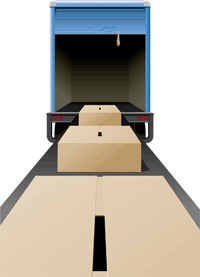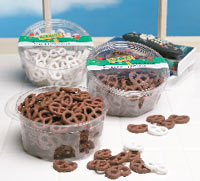
"The food industry is becoming more competitive, and many companies would rather allocate resources to product development, manufacturing, and marketing than to logistics management," said John Harold, president of Business Logistics, Scotts Valley, Calif. This has led to many successful logistics partnerships that are improving work flow as well as adding to the bottom line.

Cost reduction
Business Logistics is a consulting firm that focuses on issues related to cost reduction -- distribution, warehousing, deliveries, inbound movement of goods, customer service issues, inventory issues, as well as supply chain issues. These were all issues affecting candy manufacturer Harmony Foods, a client of Business Logistics. Harmony had consolidated six plant locations into one building, a 430,000-sq.-ft. plant in Santa Cruz, Calif. Larry Lee, vice president of operations, recognized Harmony Foods was logistically at a competitive disadvantage."One of the things we had to do was to find out where all the excess costs were in the operation and eliminate them as much as we could, then develop modern business practices that would close that competitive distribution gap," said Lee.
Lee recognized the only way to fix the internal problems was to bring in an outside source. Harold is a veteran of the food logistics industry and knew going in what would be expected. "When we come into a company, they're usually pretty interested in getting results fast," he said. Business Logistics went in looking for ways to improve how materials and information flowed through the organization, but the problem was worse than suspected. "We discovered that the right hand didn't know what the left hand was doing in most cases," said Harold. His solution to Harmony's organizational problems was to set up focus groups, bringing the right and left hands together.
"The focus groups set up by John focused on our processes and we found that our internal processes were a bit more complicated than most of us had thought in the beginning," observed Lee. The focus groups examined freight costs, the negotiated contracts with their carriers, and investigated the in-house trucking fleet. In each case, Harold noticed that the company was having to overcome the same 'obstacle.' "The main obstacle we encountered was that the company was too nice," he explained. "They were willing to do almost anything for a customer and that created all kinds of production problems, inventory management problems, forecasting problems, and increased costs -- it was a major block."
Harold first noticed this in Harmony's peg board retail rack business. According to Lee, Harmony Foods has a high rack budget for distributing its bulk goods, so cost was never an issue. "When customers wanted racks, it was a full court press to get it there, with no consideration to cost."
The responsibility of the in-house trucking fleet falls on the shoulders of Lee, who is in charge of shipping, warehouse and distribution. When Harold turned his attention to the trucking fleet, Lee feared what he might discover. "Not only was I afraid we might not be making any money, but that we could be losing money," said Lee. To find out, Business Logistics set up a separate profit & loss (P&L) statement on every truck, so all the drivers would have to do is plug in numbers once a month, making it easier to track profit and loss on private fleet trucks to determine if they were cost effective. The process compared the cost of operating these trucks, including lease costs, depreciation, taxes, insurance, fuel, labor, and administration to the cost of using public for-hire transportation services instead.
"This is a very unique approach, one that most companies do not employ," said Harold. Despite its relative success, Harold still felt the trucking fleet could be better utilized. "We are now combining shipments with other businesses that need refrigerated trucks going east and have a like requirement," said Lee.
Harold explains that Harmony's shipments were combined with another company in order to realize greater economies of scale. "We started with the private fleets of two companies where both of them were delivering to the same destinations on or about the same days of the week," Harold explained. "Where trucks were not full, we asked the other company if they had any freight to add, and if they did, it would save them having to make a trip on their own trucks for some of these deliveries."
Business Logistics also looked at combining multiple-company shipments with public carriers and found substantial opportunities to reduce costs and increase buying power. Another cost-saving opportunity is round trips, whereby one shipper fills a truck going one way and the other has a returning load. "These round trips can save over 30 percent in freight costs because they greatly increase the carriers' productivity," Harold said. In both cases, carriers make pickups at multiple locations to build their load.

On-time delivery
Not having the time or money could be considered the leading reasons a company would outsource its logistics functions, but on-time delivery to the customer can be just as, if not more, critical. Bensenville, Ill.-based Cappuccino Americana manufactures hot and frozen cappuccino for a nationally known convenience store chain whose tolerance for on-time delivery is very exacting, according to George Zerante, executive vice president of Cappuccino Americana. In an effort to meet those demands he turned to an old friend to help -- Aristides Smith, president of Inverness, Ill.-based Next Generation Logistics, Inc., with whom he had previously worked."I have been in the food industry for 25 years, and this is the second time Next Generation has been an integral part of our manufacturing and distribution system," said Zerante. Initially, Next Generation was strictly a consulting firm for small to mid-sized food service distributors and manufacturers, but Smith started receiving requests in 1990 from companies that couldn't implement his recommendations. "Either they didn't have time to implement our recommendations, or they didn't know how, or they didn't have the people, so we began assuming the operational roles," he said. Now, Next Generation has three divisions: consulting, contracting and software. "Companies have their customer service and logistics entirely outsourced to us, or they want us to interface with the carriers and book loads for them."
Originally strictly a consulting company, Smith stresses the importance of companies using consulting firms that have food logistics experience. "People say logistics is logistics, whether you move a tin can, nails, steel or food -- it's all the same thing, but it's really not. There are nuances internally in food service that are specific to the food service industry."
Next Generation also handles traffic and transportation, as well as EDI, which is the electronic exchange of documents. Working within so many facets of the food logistics industry, Smith has a broader sense of what the state of food logistics truly is. "Food service is ten years behind everyone else in terms of thought process and implementation," he observed.
One of Zerante's priorities when he contracted Next Generation Logistics was freight. He needed Next Generation to control freight costs on raw materials coming in and handle all freight going out to the distributors. "We didn't even have a freight department here, so it was taking a lot of time of people who had other responsibilities," said Zerante.
"Freight is a very large component of the food industry, about 5 percent of cost of goods," said Smith. "In order for shippers to get carriers at a reasonable cost, they are seeing that they have to spend an increasing amount of time and effort in securing reputable carriers, which leads them to either add more staff or outsource."
Next Generation has also helped Cappuccino Americana with pricing programs. When Cappuccino goes to quote a price, Zerante explains, they occasionally use Next Generation to calculate the total logistic cost including warehousing, pallets, pallet costs as well as freight costs.
Another alliance that has come as a result of Cappuccino's partnership with Next Generation is working with Next Generation's other businesses. Cappuccino has a pilot plant in the Chicagoland area that manufactures components for its final product that needs to be shipped to its manufacturing plants. "We can move our products with other Next Generation accounts to best utilize their trucks," commented Zerante.

"Chaos" and the Internet
"The Internet has helped create some chaos," commented Lawrence Gould, president of Outsource Logistics, Modesto, Calif. Gould has spent several years within the food industry, specifically the manufacturing, distribution and logistics end, and he believes the biggest impact will be made on the Internet within the next couple years by third-party suppliers. "Third-party providers are going to make a big impact because most people who decide that they want to sell over the Internet don't realize what they have to do to get the product to the customer," said Gould."There's still some uncertainty in the food industry where all this e-commerce and information flow is going to go," said Ken Thouvenot, vice president of marketing and project management, St.Louis-based Alvey Systems. Alvey provides integrated material and information flow systems. "Customers are trying to differentiate the new sales channels that e-commerce offers versus their existing sales channels."
Companies are searching for ways to implement the Internet into their daily business practices, but have been apprehensive in implementing their results. And sometimes, Smith explains, companies are having to be literally pushed in that direction. "There's been several skeptical starts," he said. "There's been much less of an Internet presence in the food service industry than anywhere else."
Larry Lee and Harmony Foods are among those skeptics. He fears with e-commerce will come the loss of personal contact with customers, and the elimination of loyalty. "There's no loyalty on the Internet, you have no real human personality to go to." Lee plans on meeting with Harold to investigate e-commerce as it affects trucking or distribution.
Cappuccino Americana has adapted to using Next Generation's e-commerce technology by tracking deliveries via the Next Generation website. Personnel from Cappuccino Americana can access the Next Generation website, dial up a code to the appropriate spot, and track its loads by the mile. Initially, Cappuccino will fax a copy of an order minutes after receiving it to Next Generation, then have that order posted on the Next Generation website. "The Internet hasn't had as big of an impact on the logistics industry as it could," said Smith. "They (the food industry) would rather invest in sales and marketing programs, even brick and mortar, than investing in information technology."
While some believe it's a lack of understanding of the Internet that has contributed to its minimal impact in the food industry, Harold points out the truth may lie behind a company's lack of understanding of its own business. "They don't really understand how their own organizations work."
The future of logistics
There are still some food companies that handle their own logistics, particularly in the baking, beverage and snacks industries, but for how much longer? Does the future of logistics lie in outsourcing? Perhaps, it's something food companies should at least take a look at, according to Harold. "Food companies owe it to themselves to take a look at logistics outsourcing. Programs today can dramatically reduce costs, improve service quality, and can be implemented with minimal business disruption."With the role of logistics changing, so has the role of the consultant. The days of going into a company, giving suggestions for improvement, and leaving are becoming a thing of the past. "Most of my customers do not want a 'theoretical' company telling them what they should or should not do," explained Smith. "They want a company that has 'domain expertise'." This has led to an increase in consulting companies making a transformation from not only recommending, Smith continued, but also implementing.